Optimal Temperature Control of Reactors - a JULABO Whitepaper
This whitepaper from JULABO provides criteria and advice for choosing the most effective and efficient solution for your application, regarding Optimal Temperature Control of Reactors.
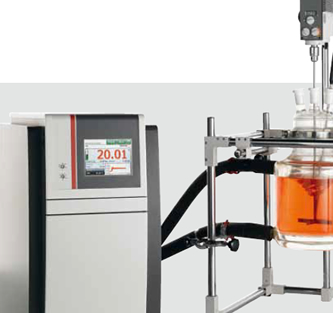
There are many applications that require Dynamic Temperature Control Systems, such as pharmaceutical and chemical laboratories, automotive, aircraft and space exploration industries, as well as pilot plants, temperature simulation and other industrial processes.
When controlling reactors, endothermic and exothermic reactions must be compensated for with extreme speed and reliability. For this, JULABO, the market leader company in high-performance & reliable temperature control devices, explains that “when choosing a highly dynamic temperature control system, a variety of conditions and influential factors must be taken into consideration. The aim must be to find the most effective and efficient temperature control for the intended application while assuring optimum functionality.” A good example of this would be the PRESTO® range.
Designed for precise temperature control as well as rapid temperature changes, the PRESTO® systems are perfect for temperature simulation situations, like reactor vessels or material stress tests.
The whitepaper also talks about the weight of safety aspects in the evaluation on temperature control solutions. Three key factors are needed in order to achieve “the best solution for a given application: process stability, investment protection and operating safety.”
In the below Whitepaper you will also find three checklists, concerning the factors mentioned above, with specific criteria within each one, for an optimised temperature-control solution.
The Whitepaper Highlights:
- How & Why Temperature Control for Reactors
- Process Stability
- Investment Protection
- Operational Safety

Temperature control of reactors
Most temperature control applications involve reactors made of glass or steel. Steel reactors are more robust and durable. Glass reactors allow the chemist to view processes within the reactor. However, glass reactors require extensive safety precautions for safe use.
Reactors generally have an inner vessel containing the samples which require temperature control. The inner vessel is surrounded by a jacket which contains heat-transfer liquid. The temperature control system is connected to the reactor jacket.
To control the temperature of a reactor, the temperature control system continuously pumps the heat-transfer liquid through the jacket of the reactor. Sudden changes in temperature within the reactor are dynamically balanced by rapid heat-up or cool-down. The liquid is heated or cooled within the temperature control system. A simplified temperature control system is shown on the right.
Examples for applications of reactors:
- Mini plants, pilot plants (e.g. pharmaceutical, chemical industries)
- Material stress tests (e.g. automotive and aircraft industries, space exploration)
- Temperature simulation
When choosing a highly dynamic temperature control system, a variety of conditions and influential factors must be taken into consideration. The aim must be to find the most effective and efficient temperature control for the intended application while assuring optimum functionality. The following chart depicts the range of possible outcomes.
How can we evaluate temperature control solutions?
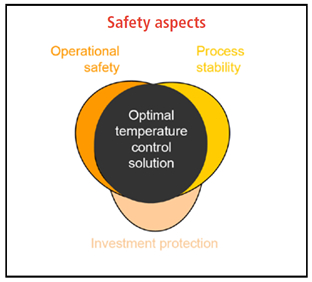
To establish a sensible rating system, safety must be a primary concern. Any decision must promise safety in many respects. It goes without saying that the safety of the operating personnel must be the top priority.
However, the final decision must reflect three additional considerations. First, process stability is vital in order to achieve flawless execution. Second, investment protection, which has two aspects:
1) finding a solution that will retain its value over the long term.
2) protection of the costly reactor equipment.
Lastly, safe operation of the overall system is essential. In summary, the best highly dynamic temperature control solution for a given application combines three key factors: process stability, investment protection and operating safety.
The figure to the right shows the maximum intersection of these criteria.
Process Stability
Materials and reactor design have a significant influence on the temperature control of highly dynamic reactor systems. Of course, a glass walled vessel will transfer heat differently than one with a steel wall. Surface area and wall thickness also have an enormous influence on precision.
Effective mixing of the starting materials within the reactor is very important for achieving good homogeneity, which in turn ensures optimal heat exchange.
Specifications established in the Pressure Equipment Directive 97/23/ EG and by manufacturers of reactors provide maximum pressure values for every type of reactor. Whichever temperature control application is chosen, these limit values may not be exceeded during operation under any circumstances. The applicable limits must be programmed into the temperature control unit before starting up a temperature control application.
Another criterion specific to reactors is the maximum permissible temperature difference (Delta-T limit). It defines the maximum difference between the actual thermal fluid temperature and the temperature of the contents of the reactor. Glass reactors are more sensitive to thermal stress than steel reactors. Any temperature control equipment should allow you to program reactor-specific values for the Delta-T limit per time unit.

Within the temperature control system itself, the following three components greatly influence the process stability:
- Heat exchanger
- Pump
- Control electronics
A temperature control solution must possess adequate cooling and heating capacity. Cooling and heating capacity greatly influence the speed to reach desired temperatures. To determine the required heating/cooling capacities, the user must consider the mass of the samples, the necessary differences in temperature, the desired cool-down and heat-up times, as well as the specific heat capacity of the temperature control medium.
Highly dynamic temperature control systems are available with air or water cooling. Air-cooled units do not use water and may be used anywhere there is adequate air flow. Heat removed from the reactor is ultimately transferred to ambient air. Water-cooled units must be connected to an existing cooling water supply. However, they work more quietly and will not add excess heat into a small laboratory, for example. If required by the application, water-cooled systems may be completely enclosed by the application.
The temperature control system's integrated pump must be powerful enough to achieve the required flow rates at constant pressure. The pump should provide the required pressure quickly and with maximum control to avoid exceeding the pressure limit values mentioned before. Regulation of pump capacity should be made in steps or by pre-setting a limit value. Pressure specifications and operating conditions of the reactor must always be considered.
Advanced temperature control systems feature pumps that automatically and dynamically balance changes of the viscosity of the heat transfer liquid to ensure continuous maintenance of energy efficiency, since viscosity affects flow and hence the heat transfer. Magnetically coupled pumps provide an additional advantage as they ensure a hydraulically sealed thermal circuit. Self-lubricated pumps are also beneficial because they are virtually maintenance-free.
The loop circuit must be a closed circuit to avoid contact of the heat transfer liquid with ambient air. This prevents permeation of moisture and oxidation and precludes the escape of oil vapours into the work environment. Temperature induced volume changes within the heat exchanger must be permanently absorbed by an internal expansion vessel of adequate size. In addition, separate cooling of the expansion vessel will ensure that the temperature control system itself will not overheat and present a risk of injury to the operator.
A temperature control system should be robust and work reliably even at elevated ambient temperatures. In many cases, the actual work environment will deviate from the ideal temperature of 20 ° C. Even the use of a mini plant places greater demands on the temperature control system. Also, during the hot summer months temperature control systems are exposed to very critical situations. Due to energy saving measures ambient temperatures in laboratories are generally higher. These examples illustrate the advantage of temperature control systems which work reliably at ambient temperatures of +35 ° C.
Highly precise temperature control is of utmost importance. The sophisticated control electronics of a temperature control system permanently monitor and control the process within the reactor and the internal processes of the system. Whenever a control variable changes, the system quickly readjusts the variable to the setpoint - without overshooting.
Precise control electronics are required for maintaining stability of a temperature control application. One way to evaluate control electronics is to examine the effort required to set parameters. Ideally, a temperature control system will require the user to enter a setpoint only. During the temperature control process, control electronics should be self-optimizing for the best possible results.
In summary, we can state that process stability and safety during reactor temperature control depends on the type of reactor, the effectiveness of heat transfer, and the efficiency of the components in the temperature control system.
Investment Protection
A highly dynamic temperature control system is a significant investment. In many cases, the costs for the reactor system and raw materials are significantly higher. For this reason, a temperature control system must not only deliver a high return on investment (ROI), but also provide reliable protection for the system and reaction materials. Accordingly, the following factors must be taken into consideration when selecting a temperature control system.
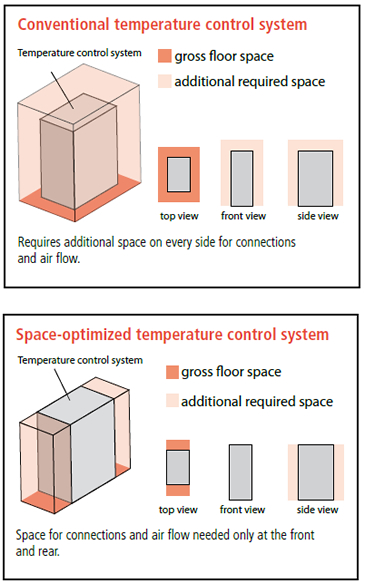
The pump integrated into the control system must produce adequate pressure and enable continuous user control, thereby protecting the application and preserving the value of the investment. If the pump is configured as a self-lubricating assembly, it will operate with virtually no wear, minimizing maintenance, downtime, and resulting costs.
Another important factor is the temperature control system's working temperature range. The wider the range, the greater flexibility you will have, again boosting the value of the investment. Ideally, one temperature control unit capable of covering a wide working temperature range will be able to handle several different applications, at a variety of temperatures, and within short time intervals. These situations are commonly encountered in busy laboratories.
If you decide that a water-cooled unit is most appropriate for your situation, make sure it has a robust and wear-free condenser integrated into the unit. This will ensure that dirty cooling water will not clog the heat exchanger. An air-cooled unit will eliminate the expense of cooling water. Even "small" factors can influence your investment. For example, having a closed temperature-control circuit will extend the service life of your heat transfer liquid.
Of course, not everything can be expressed in financial terms. Anyone who works in a laboratory knows that space is a valuable commodity. The smaller the unit's footprint, the more room you will have for your actual experiment. In many cases, gaining even a small amount of space can make a tremendous difference in the laboratory. However, to properly evaluate the size of a temperature-control system, you must look beyond just the footprint.
It is absolutely critical to consider how much space will be needed for connections and adequate airflow. A space-optimised temperature control system will have as many connections and ventilation openings on the front and rear sides as possible. Units designed in this way will save you valuable space by allowing you to place additional laboratory devices directly next to the temperature-control system. Poorly designed units will require you to reserve additional space that must be kept unoccupied for connections and/or airflow.
Finally, a temperature-control system with a long service life will extend the value of your investment. But here the user must contribute as well by performing preventative maintenance such as cleaning the condenser on air-cooled units. The quality of service and support provided by the manufacturer also plays an important role. In addition to providing competent advice and support, a reputable manufacturer will support the customer during installation and calibration as well as offer ready access to any documentation required to qualify the unit at the place of operation.
To make this go as smoothly as possible, always ensure that any technical requirements and conditions are met at the installation site, such as a suitable power connection.
In summary: highly efficient components within the system will also help preserve the value of your investment. Additionally, the temperature-control unit must reflect high quality standards. Certification according to the globally recognised DIN EN ISO 9001 standard is a clear indication of quality.
Operational Safety
The system operator is primarily responsible for ensuring the operational safety of the system set up which incorporates the highly dynamic temperature-control unit. Machinery Directive 98/37/EC states that the operator must provide users with instruction and ensure that they possess the necessary skills and knowledge. However, conscientious manufacturers of temperature-control systems go even further. In particular, they make continuous efforts to integrate improvements into their products that support the user during installation, initial operation, and daily lab work. In other words, it is worthwhile to consider what steps will be needed for installation and initial operation. Obviously, the more straightforward these steps, the faster you can start using the system.
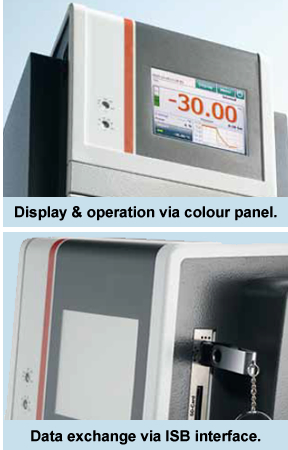
Cutting-edge temperature-control systems provide a clear and well-organised presentation of all critical information in the form of numerical values, charts, and plain text notices. During use, having information readily accessible on the display without first requiring decoding saves a tremendous amount of time. That is why information should always be shown on large displays. Having an integrated touch screen further improves user friendliness of the temperature-control system.
Cutting-edge user interfaces already have the capability of administering several different user categories, each protected by a password. The administrator also has the ability to set commonly used parameters in advance. Other employees are given limited access rights that allow them to simply retrieve these settings. This can greatly simplify procedures in the lab and prevent unintended parameter changes and malfunctions.
Another criterion for improving user safety is the availability of extensive interfaces that allow remote control of the temperature-control system through a network or a control centre. Direct operation of a temperature-control system is not always desired or even possible. Modern interface standards such as Ethernet or USB provide the ideal conditions for accessing all system functions remotely. The user's job is made much easier when the network-based user interface has the same functionality as the interface on the temperature-control unit. This helps flatten the learning curve and avoids operator error.
It is common practice in laboratories to conduct a series of experiments under identical temperature conditions. Even failed experiments usually must be repeated precisely under the same control parameters. The temperature-control system should contain functions that enable precise reproducibility in these situations. These functions simultaneously lower the expense of generating documentation for an experiment.
Although temperature-control systems are increasingly equipped with intuitive operating functions, it is still advisable to inquire about user training from the manufacturer of the system. Users must be very well trained in order to competently handle increasingly complex systems and ever more stringent requirements to properly execute experiments.
Operational safety is often dependent on factors that appear to have almost marginal importance. For example, it is worthwhile to confirm the working temperature ranges covered by specific heat-transfer liquids. Some temperature-control systems can use a single heat-transfer liquid across their entire working temperature range, thereby sparing the user the hassle and expense of changing the liquid. This also makes inventories more straightforward. As a result, laboratories can conduct a series of tests at low and high temperatures without pausing to drain the liquid, clean the unit, and refill with a different liquid. This greatly improves the flexibility of the temperature-control system while saving a lot of time as well.
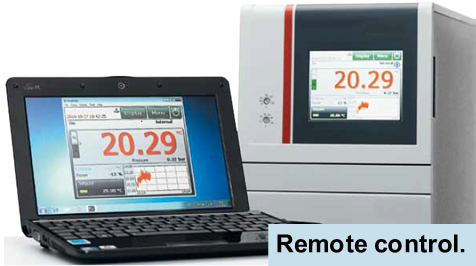
If the temperature-control system is located in the same room as the lab workers, the noise of the system is another important criterion. Fortunately, there are temperature-control systems that emit little more than a whisper while in operation, resulting in a significant ergonomic benefit. You also do not want to underestimate the importance of an easily accessible filling port. The location of the filling opening should make filling the unit as easy and trouble-free as possible.
If the temperature-control system will be used in several different locations, transportability must be considered in advance. Are several people required to transport the unit or can one person easily move it by themselves?
Ultimately, operational safety depends on every factor that plays a role during daily use of the temperature-control solution. The most ideal temperature-control solution will permit rapid installation and start-up, have easy-to-learn operating procedures and useful details that make operation more comfortable, more ergonomic, and safer.
Be sure to check out the following checklists as they sum up the findings discussed in this Whitepaper.
Where Can I Learn More About Temperature Control?
You can find out more about the PRESTO® range on our website or contact our Sales Team, who will be happy to help you find the right solution for your requirements.
In addition to that, you can also Download the Whitepaper to read the findings in full.
Contact Us Today! |
Witness Flow & Batch Chemistry Live with Lab Unlimited
This year we will be hosting a number of Roadshows, workshops and Seminars about Flow & Batch Chemistry throughtout Ireland. Ensure you don’t miss a show near you by subscribing to notifications on upcoming dates & locations.
Keep an eye on our Blog, Twitter and LinkedIn pages as well, for upcoming news.

Want to Know More?
Contact our Sales Team for more information on Chemical Reactors or check out our website to see the Flow and Batch Chemistry Reactors we have available. We will help you find the right system for your application!

